2007 Interview Guide for Never In Care Project
Attachment 3 Interview Guide.doc
Surveillance of HIV/AIDS Related Events Among Persons Not Receiving Care ("Never In Care")
2007 Interview Guide for Never In Care Project
OMB: 0920-0748
Attachment 3. 2007 Interview Guide for Never In Care Project
Never in Care Project
(NIC)
2007 Interview Guide
Overview
This interviewer guide is for those administering and supervising the administration of the questionnaire for the Never in Care Project (NIC). The first section of this document discusses the rationale and objectives of NIC. Understanding the rationale and objectives is important because it may help you justify participation to others and thus motivate persons to join the study or to provide valid and complete information. The second section of this guide is on quality control. In this section, we introduce those areas in which you have control in collecting valid and complete data. The third section of this document is about basic interviewer skills. This section describes the set of key interviewing skills that are necessary to develop rapport with respondents, and the skills necessary to identify and address non-verbal and verbal cues that suggest miscommunication or inconsistent responses. The fourth section is about identifying, addressing, and resolving problem indicators. The fifth section of this document provides general instructions on administering the questionnaire. The sixth section of this document covers issues unique to starting the survey on the handheld computer. The seventh section discusses administering or coding responses to each of the questions in the eligibility screener. The eighth section reviews the procedures for documenting informed consent. Lastly, the ninth section details instructions for administering the Non-Response Form.
Use this guidance in conjunction with the NIC protocol to help you in your duties as an interviewer or supervisor for this project. The success of this project rests on you. The ability to translate data into findings that can assist in improving services for HIV-infected people and in preventing the spread of HIV are only as good as the quality and completeness of data that you collect.
1. NIC Rationale and Objectives
1.1 Rationale
Because of treatment advances, more people with HIV infection are living longer and healthier lives. Persons who know they are infected can benefit from monitoring of their immune status, and, when recommended, treatment with antiretroviral drugs and prophylaxis for opportunistic infections. Additionally, new HIV therapies may reduce the degree of infectiousness by lowering viral load, thereby reducing HIV transmission. However, one cannot achieve these benefits without linkage to care. The Center for Disease Control and Prevention’s (CDC) Strategic Plan for HIV Prevention sets a target of entry to care within 90 days of diagnosis. Capacity to evaluate progress toward this goal is limited in that existing HIV/AIDS surveillance systems provide little information about HIV-infected persons who are not in care, especially those who have never entered care. In addition, an estimate of the size and clinical status of the latter group is critically important for estimating resource needs to support linkage to care. Furthermore, identifying factors related to not being linked to care will be important in designing effective interventions. The NIC Project aims to address these gaps.
Funded jurisdictions and the Department of Health and Human Services (DHHS), Health Resources and Services Administration (HRSA) will use the findings to plan and allocate resources for HIV-related services. CDC will use the findings to measure progress toward the HIV Strategic Plan and Advancing HIV Prevention (AHP) initiative goals. The findings will also be used to develop recommendations to address unmet need and strategies to link HIV-infected persons to care.
1.2 Objectives
The overarching objective is to describe the population of persons who are HIV-infected, are at least 90 days post diagnosis, and have never received HIV care. A secondary objective is to compare this group with HIV-infected persons who have received HIV care within 90 days post diagnosis.
Specific aims:
To identify and describe persons who have been diagnosed with HIV for at least 3 months, but who have never received medical care for their HIV infection;
To ascertain barriers to receiving HIV care associated with never having received care;
To compare the characteristics of HIV-infected persons diagnosed with HIV for at least 3 months, in care and never in care;
To determine the immunologic status of persons who have had a diagnosis of HIV infection for at least 3 months, but who have never received care, to estimate the added resources that would be required when these individuals are linked to care; and
To monitor the impact of interventions to link diagnosed persons to HIV care.
2. Quality Control
The collection of high-quality interview data is crucial for meeting the NIC objectives.
Not everyone can be an effective interviewer. Essential traits needed to be a successful interviewer include:
Being people-oriented and responsive to others
Relating easily with a wide variety of people of different demographic and social backgrounds, personalities, and sexual orientations
Being comfortable with your own sexuality and feelings regarding illegal drug use and HIV/AIDS
Being detail oriented, organized, and methodical
Having a desire to contribute to expanding the knowledge of HIV prevention and care at the local and national level
The following are some important strategies that help interviewers obtain high-quality data: (1) establish and maintain rapport with respondents; (2) appropriately identify, address, and resolve both verbal and nonverbal problem indicators; (3) administer the questionnaire in a standard way, yet tailor it to the respondent as instructed; (4) translate the underlying intentions of specific measures, if necessary; and (5) review the questionnaire for errors, and identify and correct those errors which can be corrected. Each of these critical quality-control topics is discussed in the following sections.
3. Basic Interviewer Skills
3.1 Establishing and Maintaining Rapport
The more comfortable the respondent is with you, the more likely she/he will provide honest and complete answers. You establish rapport when the respondent perceives you as a nonjudgmental, understanding and caring person. To establish rapport, it is also helpful to have a warm and engaging introduction, a comfortable interview environment, and appropriate use of body language and humor.
To establish rapport, first be aware of your own feelings and the nonverbal and verbal signals you may send to respondents. Before your interviews, ask yourself
the following questions:
1. Are you feeling and looking relaxed?
2. Is your body language open or closed?
3. Are you angry or upset about something or someone? Can your appearance be interpreted as stern, inflexible, or self-righteous?
4. Do you appear as if you enjoy and value your work?
During a long survey, it is difficult to always be your best when interviewing respondents. After recognizing your feelings and the signals you may give on a particular day or interview, minimize those verbal and non-verbal signals that can be perceived as judgmental, disinterested, or non-caring. If you cannot effectively minimize these signals, please do not administer the questionnaire.
3.2 Introduction
The most important time in which to influence a successful interview may be the time when you first introduce yourself to the respondent. During the introduction, demonstrate interest and appreciation for their participation.
3.3 Responding Empathetically
Some of the questions that you ask during the interview may cause respondents to recall difficult experiences in their lifetimes. Be prepared to respond appropriately to these disclosures and the range of feelings that might accompany them. Allow time for the respondent to work through the disclosure and respond empathetically if appropriate. Being empathic (showing empathy) means understanding and appreciating the respondent’s feelings and personal situation; this is not to be confused with feeling sorry for someone. This is an important foundation on which to build rapport. As much as your personal experience might allow, demonstrate empathy verbally and non-verbally during your interactions. Be aware that even an empathetic statement may undermine rapport if not conveyed sincerely.
3.4 Humor
Humor can bring relief to tense situations and can give a sense of perspective by showing that you don’t take yourself too seriously. Within reason and personal comfort, use humor to help put nervous respondents at ease, and use it to help you cope with your work! However, do not overuse humor as it can be distracting and undermine your purpose. Use your best judgment when applying humor to build rapport.
3.5 Closure
Close the interview with the same attention and commitment to your client as you demonstrated during the introduction. Be gracious for their time and participation. Be sure to attend to their needs, including providing information about follow-up health care or other services, if appropriate, as directed by your supervisor. Remember that even though the respondent may have seen you only once, you might be the only person to whom she/he ever disclosed certain experiences or emotional states that warrant follow-up and possible intervention.
3.6 Staff Conduct
Do not try to be the participant's best friend. By maintaining a professional yet friendly demeanor you will help complete the interview in a timely manner and be a better representative of the project and your agency. Some “small talk” at start and closure are useful rapport builders; but to the greatest extent possible, outside the administration of the interview, you should be mostly listening and not speaking. Do not make inappropriate disclosures that could appear unprofessional. Examples of inappropriate disclosures might include the sharing of personal experiences of a sexual or drug taking nature. Contrast “yes, I know always using a condom can be hard” (OK) with “yes, I haven't used any condoms with my last 2 partners either” (not OK).
Staff working on NIC should abide by their state/local HIV/AIDS surveillance security and confidentiality requirements and guidelines. In addition, the following are guidelines for conduct:
• Do not come to work under the influence of alcohol or drugs
• Do not have sex with participants during the project period
• Do not use drugs with, sell drugs to, or buy drugs from participants during the project period
• All participant incentives for the project must be accounted for; the interviewer is responsible for the appropriate distribution of incentives and the return of undistributed incentives to the state/local project site
These guidelines apply to both staff conducting interviews, and all other staff working on the project. If you believe a staff member has breached these guidelines or state/local guidelines, report it to your supervisor or principal investigator.
4. Identifying, Addressing, and Resolving Problems
In order to assure that respondents provide reasonably consistent responses, you must be able to identify that there may be a problem (“problem indicator”) then address and resolve problems; this is a critical ongoing priority for obtaining high-quality data. In this context, problem indicators are either non-verbal or verbal cues given by respondents that suggest confusion or misunderstanding, inconsistent or incomplete disclosures, or other problems (stress, fear, impatience, anger, etc.).
Because even simple ordinary speech is frequently misunderstood, and because the language in the questionnaire is frequently technical and may be demanding (e.g., may ask the respondent to recall events), you must always consider the possibility that the respondent may not fully understand a question. In addition, some respondents may be troubled by the content of some questions, and some may withhold information on purpose. To obtain useful data, you must be an attentive observer and listener in order to recognize these problem indicators, and you must “think on your feet” to address them. Falling into a “habit,” and administering the questionnaire in a rote, mechanistic, and non-thinking manner will keep you from picking up and responding to these cues. It is important to stay alert.
4.1 Awareness of Respondent
Be observant about the respondent’s behavior and apparent level of comfort throughout the interview. Stay tuned to their facial expressions, tone and speed of voice and posture, and recognize potentially problematic non-verbal and verbal signals. If a respondent exhibits anxiety or disinterest, temporarily stop the interview and explore her/his reactions. Section breaks within the instrument offer good opportunities to stop and assess these problematic reactions.
Another factor in being aware of the respondent’s signals is that they may not be able to complete the interview and provide high quality data. If a participant appears to be intoxicated or under the influence of drugs, the interviewer should terminate the survey as soon as possible and make a note in the comments that the interviewer determined that the respondent was not able to complete the interview. The respondent should be compensated and thanked for his/her time.
Similarly, if you believe the respondent is not telling the truth about some of the questions, you should make a note to that effect in the interviewer comments. If the respondent consistently gives what you believe are inaccurate or untruthful answers, the interview should be stopped and a note put in the interviewer comments to that effect. The respondent should be compensated and thanked for his/her time.
4.2 Active Listening
To listen actively, periodically paraphrase key respondent responses to ensure accurate communication and to inform respondents that you are attentive. Paraphrasing involves using different words to say what the respondent already said. Responding with "It sounds like..." or "I hear that..." are frequently used active-listening transition statements. After these statements it is good to also ask “Is that right?” or words to that effect, to encourage the respondent to correct your information if needed. For example:
Respondent: “I’m not sure. I have had lots of sex partners; it’s going to be hard to give you an exact number.”
Interviewer: “Ok, it sounds like it may be difficult. Take your time to think about it.”
Although active listening is important to fully understand respondents’ answers, it should not be used as a means to suggest a response or to help a respondent choose a particular answer. Some kinds of questions used in ordinary conversations must be avoided because they suggest answers. For example:
DON’T ASK: “Do you mean A or B?” This is not neutral because it suggests two possible answers and there may be others that do not occur to you as the interviewer, but may be appropriate to the respondent if left to choose on his/her own.
DON’T ASK: “Do you mean (such and such)?” because many people tend to say “Yes” to any suggestion, either because it’s easy or because they think it is the “right” answer.
DON’T ASK: “Then you feel (such and such)?” Even though you think you’re summarizing what the respondent has already said, your interpretation may be correct, but you may be placing the emphasis in the wrong direction.
4.3 Responding to Problems
When checking in with respondents, acknowledge your observation (e.g., “You seemed hesitant to answer that question..”), explore and clarify concerns (e.g., “Are you concerned about what will happen to your answers?”), and respond appropriately (“We protect your information in many ways....”). Interviewers may find that assuming someone's mood, disposition or attitude may result in anger, alienation, and/or termination of the interview. It places the interviewer in a very precarious position. If this client suffers from an anxiety disorder, the comment may be interpreted as confrontational, no matter how mildly and politely it was intended. Other options for obtaining a subjects response to a question might include “Do you have any concerns about this question” or “Can I help clarify anything?” It might be better to help open the conversation by seeking to understand the client's discomfort. Certainly, verbal and non-verbal problem indicators have many causes over which the interviewer has no control. Evaluate whether the cause might be attributed to the interview process or uncertainty in participating in this surveillance effort. Within reason, try to understand the underlying issues and respond appropriately. When needed, reassure the respondent that:
S/he is a participant in and not just the subject of NIC.
We are interested in learning about her/his experiences, perceptions, and opinions. That is, we believe that her/his experiences are valuable and important for HIV prevention and improving the quality of care: "We hope you can help us understand"..."We want to hear what you think"... etc.
We are also interested in the variety of experiences and opinions s/he has. We do not want to come across as prying. We want to approach the respondent in a way that he/she doesn’t censor his/her own responses.
5. Questionnaire Administration: General Guidance
5.1 Administrative Issues
Prior to administering the interview, complete required activities and cover important administrative issues. These activities and discussions include obtaining consent for the interview, which ensures that the respondent understands the project, and discussing the amount of time required for the interview, confidentiality protections, reimbursement, and other concerns or questions the respondent may have. Remember to make the respondent feel as comfortable as possible and ensure her/his basic needs are met (bathroom, etc.) Explain to the respondent that s/he can ask questions at any time. Remember, these pre-interview discussions are important opportunities to establish rapport and facilitate successful interviews. As you enter these interactions, be aware of your own mood and the mood and manner of your client.
5.2 Questionnaire Structure
The questionnaire is divided into modules, each of which cover a particular domain (eligibility, demographics, HIV testing, barriers/facilitators to HIV medical care, therapy, care-seeking behavior, unmet needs, social relationships, risk behavior, and interview completion.) Within each section is a list of questions for that particular module. These section headings are to help guide you through the instrument, but are not indicated to the respondent.
Instructions for you, the interviewer, are enclosed in grey boxes and entitled Interviewer instructions. On occasion, you are instructed to read to the respondent. These instructions are typically in quotations and in regular font. They are enclosed in boxes and begin with the instruction SAY. You may also find instructions embedded in the question. These instructions are in bold, capital letters, italics, and typically enclosed within brackets or boxes.
Not all questions are intended to be asked of all respondents. On the paper version, instructions to skip particular questions are positioned either next to responses, at the top of some questions, or at the bottom of the page or question; on the computer, the skips are automatic.
5.3 Standard Administration
Administering the questionnaire in a standard way is critical for collecting high-quality data that can be combined and analyzed from all interviewers and sites. Please follow the instructions below. This is imperative in order to assure that all interviewers administer the questionnaire in the same manner.
1. Ask all applicable questions within each section in numeric sequence. Do not ask questions out of sequence unless you are instructed to do so.
2. Read clearly and exactly as written all respondent-instruction statements (in regular font within boxes interspersed throughout the questionnaire). Most sections begin with one or two sentences that begin with "SAY: ...." These important sentences are included in the questionnaire to help the respondent make the transition to a different topic. NOTE: While you may have read these instructions numerous times, this is the respondents’ first time hearing them. Therefore, do not rush through these instructions. After reading the instructions, check in with the respondent to ensure they understand what you’ve just read.
3. Read each question completely.
4. Read each question in a comfortable style and at an appropriate speed, maintaining eye-contact. Maintaining eye contact is important so that you can stay connected with the respondent, demonstrate interest and empathy, and evaluate and respond to problem indicators.
5. When instructed in the questionnaire, read the entire set of responses for specific questions. ‘Read required response’ instructions are positioned under specific questions and identify which responses are to be read. Even if a respondent selects a response before all possible choices have been read, take time to read all response options. The only exception is if a respondent “never” engaged in a particular behavior, “didn’t use” a particular substance, or “didn’t go” to a particular place; then the remaining frequency options are not read.
6. Do not read responses unless specifically instructed. When responses are not to be read, instructions are positioned under those specific questions.
7. When instructed, use standard response cards for specific questions. Prior to use, routinely orient all respondents on how to use the response cards. Response cards should be made of sturdy material, preferably laminated, and include the set of responses for only one question (i.e., one response card per question). The set of response cards should be readily available. Be sure to pause in order to give the respondent time to review the response card.
8. When instructed in the questionnaire, assist respondents in recalling specific events. Respondents will have to recall sexual and drug use behaviors since testing positive for HIV and prevention activities in which they might have been involved since testing positive for HIV. These different recall periods place considerable recall demand on respondents. It is very important that you pause and ensure the respondent understands the recall period or particular event in question.
9. In some cases, it may be acceptable to use slang or every day language, in addition to or in place of our more technical terms. For example, some local terms about drugs and drug use may be used to help the respondent understand the question better. Also, some sexual behavior vernacular may also be used to help translate our technically-defined behaviors.
5.4 Recording Responses
When using the handheld computer, responses are recorded by using the stylus to click on the appropriate response on the handheld screen. In addition, responses to structured questions are formatted in different ways. Thus, you will record responses by either checking designated response boxes or recording answers in defined (e.g., number of partners) or open-ended fields (e.g., reason why respondent didn’t seek HIV care soon after diagnosis). Please familiarize yourself with how responses are coded for particular questions, and please be careful in recording responses. Filling out the questionnaire will become second nature to you, and you will want to make the interview as brief as possible for the respondent. However, rushing through the questionnaire produces careless errors, which will be returned to you for correction. Please follow the guidance below in coding responses.
1. When to code. The only time an interviewer will leave all responses for a question blank is if the question has not been asked (e.g., when it falls under a skip pattern).
2. Single or multiple responses. Most questions will require you to code only one response; however, several questions will require you to code multiple responses. Single-response questions typically do not have interviewer instructions; however, in some instances you will be instructed to “read choices” and check only one response. Multiple-response questions will have an instruction telling you to “check all that apply.”
3. Other responses. Some questions have an “Other” response option which you can use to record responses that haven’t already been provided. A line is provided next to “Other” for you to clearly record, verbatim, the respondent’s answer. However, check to see if the answer fits a structured response before marking “Other.” Reserve “Other” for responses that are not equivalent to those which are already provided. If you are unsure if a response is equivalent, make appropriate notes in the interviewer notes (computer) or margin (paper) so that your field supervisor can make a determination.
4. Open-ended questions. A few questions are open-ended and do not have structured responses. As with “Other,” clearly record the respondent’s answers verbatim on the space provided. When needed, ask questions that will help the respondent clarify their answer, but be careful not to lead the respondent (see examples in section 4.2). Again, if a respondent’s answer to an open-ended question is not explicit, ask a clarifying question and then clearly record exactly what the respondent said. Code the response that most closely matches the answer from the list provided. If you are using the handheld computer, it will automatically display the open-ended response and instruct you to code the response from the list. Do not read the list of coding options to the respondent.
5. Unknown responses. There may be times when a respondent does not know the answer to a question. Many structured questions include a “Don’t Know” response. Please code these responses only when absolutely necessary. Before coding “Don’t Know,” probe to see if you can code part or all of the answer (e.g., date of most recent HIV test). However, do not lead the respondent to a particular answer. An unknown answer is always better than a contrived answer. All unknown responses are coded as “??” or “.D” in the handheld computer or some combination of a “9” (e.g., “09”, “99”, etc.) on the paper form.
6. Refused responses. Nearly all questions have a “refused response” option. Use your judgment about whether to probe when a respondent refuses to answer a particular question. All refused responses are coded as “.R” when administered using the handheld computer or some combination of a “7" (e.g., “07”, “77”, etc.) on the paper form.
If for some reason you are unable to code a confusing response, record information about the response you received in the interviewer notes (computer) or margin (paper). This information can be used by the coordinator later to help you come to a decision regarding the coding of a confusing response.
5.5 Additional Guidance When Using Paper Surveys
1. When using the paper interview, familiarize yourself with the designated skip patterns within each section and skip to appropriate questions when instructed. Failing to skip particular questions or inappropriately skipping questions are common, but preventable errors. If you accidentally skip a section during an interview, return to that section and administer it.
2. When using the paper version of the questionnaire, be sure to mark a response from the list given for structured questions; only write in responses for open-ended questions, for which no response categories are provided.
3. Unreadable handwriting (e.g., 4’s that look like 9’s) and misplaced checkmarks that overlap response boxes are common errors that undermine the validity of data collected on paper questionnaires. Please record responses such that they are unquestionable.
4. Following the interview, if you missed some questions do NOT code any response and do NOT code “Don’t Know.” Even if you think a particular response would apply to the respondent, it is critical that you leave all the responses to these missed questions blank.
5. When you must use a paper version of the survey, be sure that you have all documents and that the NIC respondent identification number is filled out on the top of each of these forms.
6. Starting the Interview with the Handheld Computer
6.1 Survey Information Section: Handheld Computer
Before beginning an interview, verify that the handheld computer’s date and time is set correctly. When you first launch the survey in the handheld computer, a number of questions will appear that you need to complete. All of the information requested when you first launch the NIC survey in the handheld computer is critical. Pay close attention to the detail requested in this section. Accurately enter the information. A brief description of the items follows:
-
NIC Respondent ID:
Respondent ID is the 22-digit code assigned to the person selected to participate in the interview.
Interviewer ID:
Refers to the unique 3-digit identification number of the interviewer. The Field Supervisor will assign each interviewer an ID number to use throughout the survey period.
6.2 Survey Information Section: Paper Forms
There are several additional fields that must be filled in on the paper forms, which are described below. These are automatically completed by the computer so you won’t need to complete them when using the electronic version of the survey.
-
Date of Interview:
Write in the month, day and four-digit year for the date you conduct the interview.
Time began:
Write the time the interview began. Be sure to check “AM” or “PM.”
Time ended:
Write the time the questionnaire was completed.
6.3 Ending the Survey Prematurely
Situations may arise where an interviewer must end a survey before the last question in the interview is asked. Such situations may be initiated by the participant or the interviewer. For example, interviewers may end an interview early if they find the participant is “too high” to respond to the questions in the survey.
If an interviewer feels he/she needs to end the interview early, the first step is simply to end the interview verbally with the participant by thanking him/her for their time as you would at the end of the interview. Interviewers should be cautious about telling the participant that the interview is being terminated early or the reason for terminating the interview early because it may frustrate or anger the participant. Participants who begin but do not complete the survey should still be compensated when the interview is terminated.
To end a survey early on the handheld computer, the interviewer should first enter interviewer comments for the open question on the handheld computer. In the comments, the interviewer should explain the reasons the interview was prematurely ended. After entering the interviewer comments, the interviewer would then end the survey. Instructions for entering interviewer comments and ending an interview early are provided in the handheld computer basic training, which is included in the QDS manual. It is important to enter the interviewer comments before ending the survey, because the data manager will need to determine if the interview was valid prior to shipping the data to the Centers for Disease Control and Prevention (CDC).
6.4 Entering Data on Handheld Computers
This section explains the data entry and interviewing process on the handheld computers. It briefly explains the following:
1) Handling interviews on the handheld
2) Entering letters and numbers
3) QDS HAPI program basics
4) Handling the pocket pc device.
Handling interviews on the handheld:
Opening the survey:
1) Go to Start ► Programs ► QDS HAPI.
2) Tap “Interview” on the lower left section of the handheld device
3) Tap on the “Begin” option here.
4) An open screen shall pop-up.
5) On this screen, tap on “NIC 2006 vXXX En HAPI”
Ending the survey:
1) Survey will automatically close at the end of the Interview Completion module.
2) DO NOT tap on the “X” in the upper right. This will not close the survey properly and the
data won’t be encrypted.
3) If it is necessary to terminate the interview before it is completed, Tap “Interview” and then tap
“End”
Interrupted Interviews:
If respondent needs to take a break, leave the survey open and wait for respondent, you then may need to perform the following:
If the handheld backlight has turned off after 2 minutes:
• Tap the screen to turn it back on.
• Survey will appear where you left off.
If the handheld has turned off completely after 5 minutes:
• Turn handheld on.
• Survey will appear where you left off.
If the interview was terminated before it was completed and needs to be resumed, the following steps need to be followed:
1) Tap “Interview” on the lower left section of the handheld device, and then tap “Resume”.
2) Tap on “NIC 2006 vXXX En HAPI” on the open screen that pops up.
3) An “Interview List” screen will pop-up. On this screen, tap on the incomplete interview. A pop up box will confirm the interview being loaded.
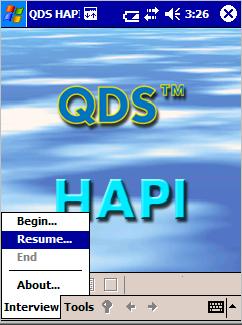
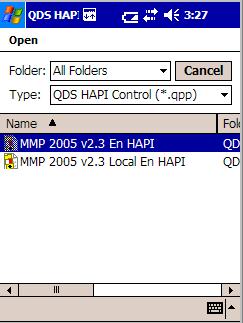
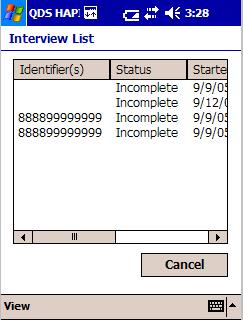
Entering letters and numbers:
There are several ways text data can be typed into the handheld device. The Windows PocketPC 2003 consists of the following SIP’s (Soft Input Panels)
Block Recognizer
Keyboard
Letter Recognizer
Transcriber
W e
recommend the use of keyboard for entering the text data.
e
recommend the use of keyboard for entering the text data.
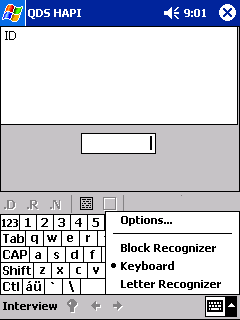
Using the keyboard SIP:
1) Tap the SIP selection area on the right bottom corner of the handheld screen to select the keyboard SIP. A small keyboard icon will appear as a block. To enable the keyboard, tap on the keyboard block. A picture of a keyboard appears on the screen.
2) Enter the letters and numbers by tapping the keyboard.
3) Use the Shift and the Caps options to switch between lower and upper case for text and between numbers and symbols.
4) For more symbol options, tap the123 key in the upper left corner of the keyboard.
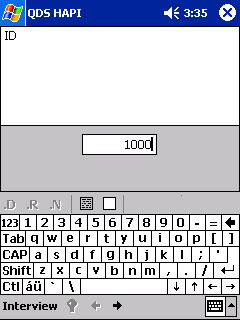
The keyboard SIP will automatically be activated while using the HAPI program when a textbox or text area has been tapped.
III. HAPI program basics:
Reading Questionnaire Text:
I nterviewer
Instructions are in bold and/or italics and SHOULD
NOT be read to the
respondents.
nterviewer
Instructions are in bold and/or italics and SHOULD
NOT be read to the
respondents.

The interview questions appear in plain font and should be read to the respondents.
Some questions are only for the interviewers and are not meant to be asked to the respondents. These are generally preceded by the instruction “Interviewer instructions:”
References to the show cards and special response sets are made as special instructions to the interviewers.
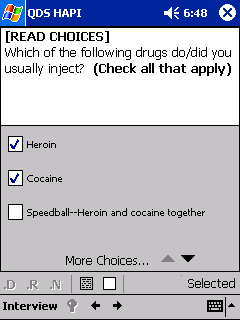
Moving Between Questions:
The questions and instructions in the HAPI program appear in a linear sequence. The skipping between questions follows a linear pattern and can be done only one question at a time.
• Advance to the next question by tapping the forward arrow at the bottom of the screen.
• If an answer to a question is required, the interviewer cannot advance without entering an answer and the forward arrow will be grayed out.
• Go back to previous questions by tapping the back arrow at the bottom of the screen.
• When moving back to the previous questions, the HAPI will skip all instructions to the interviewer.
Entering Special Responses:
The Don’t Know (.D) and Refused to Answer (.R) are called the special responses for the HAPI.
Tap .D in order to enter the Don’t Know response.
Tap .R in order to enter the Refused to answer response.

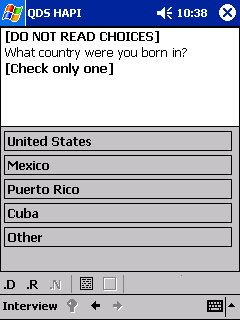
Clearing an entry:
To clear an entry, tap on the empty box below the question area.

T
 he
interviewer can add comments to each question by tapping on the
filled box below the question.
he
interviewer can add comments to each question by tapping on the
filled box below the question.
After entering interviewer comments, click on “ok” or “X” at the upper right to return to questionnaire.

Entering Dates:
Dates always need to be in MM/DD/YYYY or MM/YYYY format.
The interviewer must enter the “/” between the numbers.
Example: November 1, 1980 would be entered as: “11”, “/”, “01”, “/”, “1980”
Most dates in the questionnaire are in a MM/YYYY format (exception: Date of Birth, PDP Start Date.)
When a respondent knows the year but not the month:
Probe to assist respondent in remembering.
If additional probing is not successful, enter the date information in this format:
“??/YYYY”
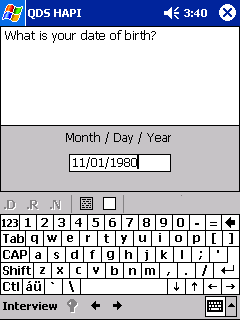
Entering Single Choice Responses:
Use the stylus to tap the box that applies.
The questionnaire will automatically advance to the next question when an answer is selected.
Entering Multiple Choice Responses:
Use the stylus to tap the boxes that apply.
A checkmark appears in the checked box or boxes.
The questionnaire does not automatically advance.
The interviewer must tap the forward arrow at the bottom of the page.
Some questions have a list of answers which do not fit on one screen (Indicated by the “More Choices” phrase at the bottom of the answer list).
Tap on the down arrow to the right of “More Choices” to see additional answers.
IV. Handling the Handheld Device:
Handheld Battery:
• Keep the battery charged when handheld device is not in use.
• The handhelds will come with a battery expansion pack to provide longer battery life.
• The battery has an estimated life-time of five hours.
If the battery dies
you will lose all data plus the questionnaire program!
Other Care Instructions:
• Only use the stylus with the handheld.
o•Don’t use pens, pencils, other sharp objects on screen.
• To clean the handheld use soft, damp cloth moistened with water only.
• Keep the handheld away from temperature extremes and moisture/liquids.
• Do not expose handheld to direct sunlight.
• Store in protective case to keep screen from getting scratched.
• Keep the handheld secure when not in use.
7. Eligibility for Interview: Specific Guidance
The eligibility criteria to be used for all participants are the following:
Has not previously completed an interview for NIC during the survey period
Is a resident of one of the participating sites
Is age 18 years or older at the start of the interview
Is able to complete interview in English
Is aware of her/his HIV status
Has never been in HIV medical care
If the participant is not able to complete the interview in English, please note this in the interviewer comments. If possible, also note the language the participant speaks. If a translator was used or a proxy (relative or other person) responded on behalf of the participant, this should also be noted.
8. Consent Procedures
Interviewers should follow local consent protocol before administering the questionnaire to eligible respondents. You may find the informed consent procedures in the NIC Protocol.
8.1 Incarcerated Populations
Interviewers should take additional precautions when working with incarcerated persons to prevent possible harm or coercion. Detainees may take notice of a respondent being called out for an interview and either infer the HIV status of the respondent or assume that the respondent is trading secrets for favor within the correctional facility (“snitching”). Interviewers should ensure that the respondent has the option to participate or not participate without repercussions to their care or from the administration of the correction facility, including guards. Interviewers may need to reaffirm the voluntary basis of the project with correctional staff who are assisting with recruitment and escort of prisoners.
9. Non-Response Form
The Non-Response Form collects a minimal amount of basic HIV surveillance information. You may extract this data directly from the HIV/AIDS Reporting System (HARS) or other HIV data sources. Only use the Non-Response Form for selected persons who decline to participate in the interview.
| File Type | application/msword |
| File Title | Never In Care Project |
| Author | DTBE User |
| Last Modified By | arp5 |
| File Modified | 2007-05-18 |
| File Created | 2007-05-18 |
© 2026 OMB.report | Privacy Policy